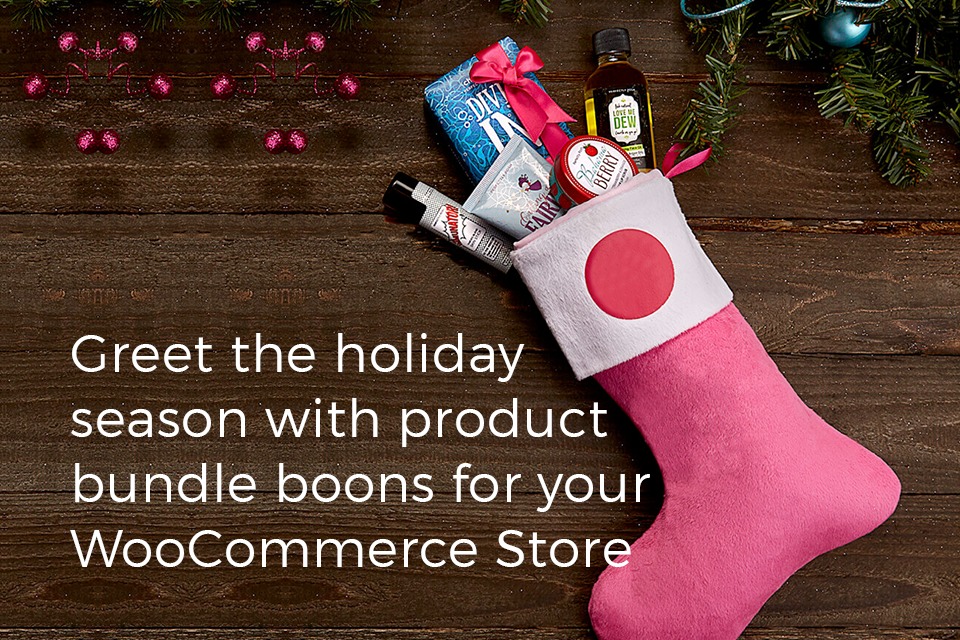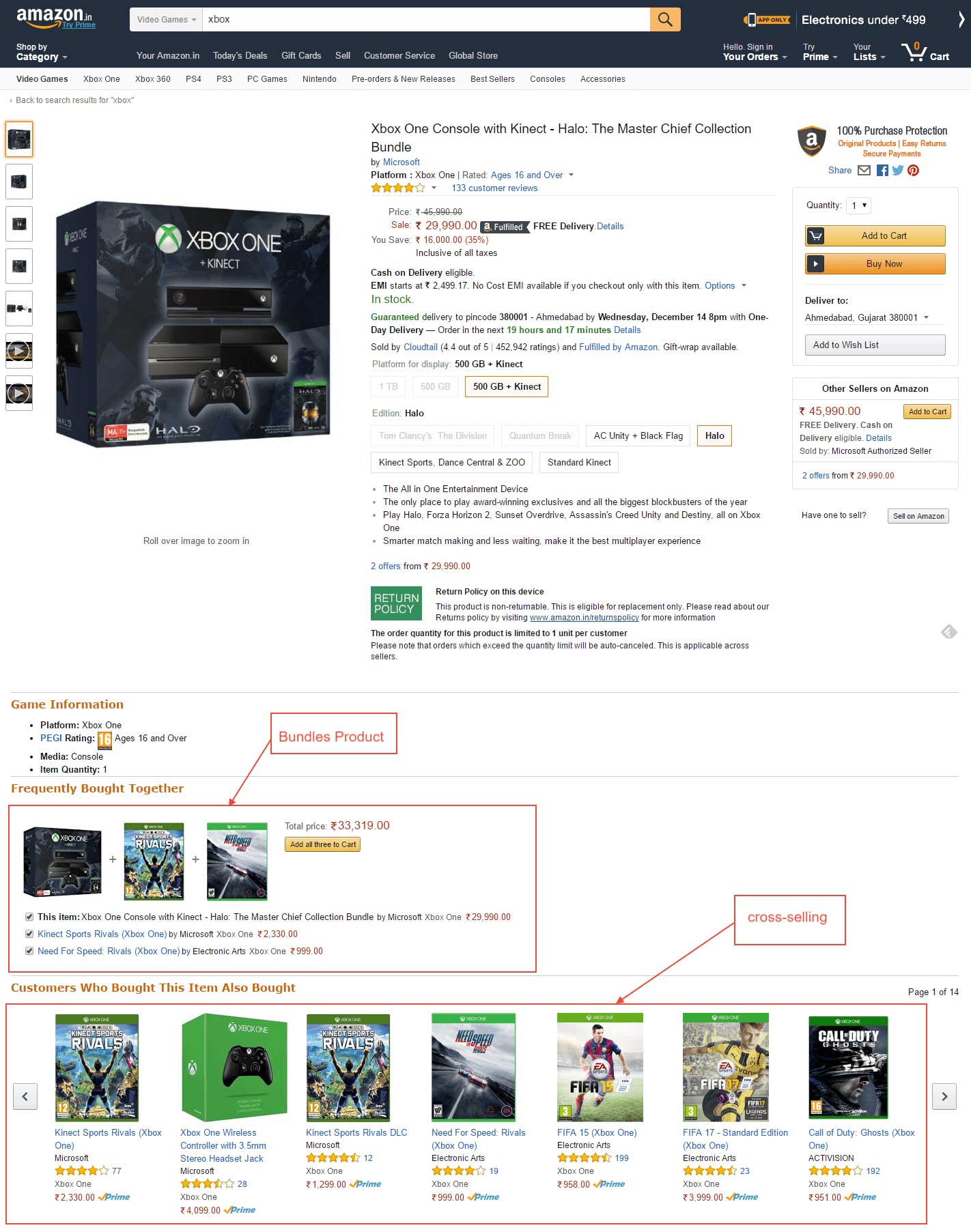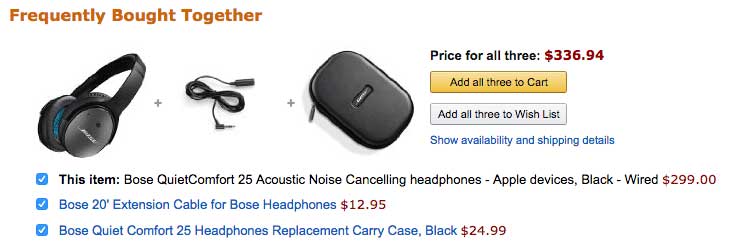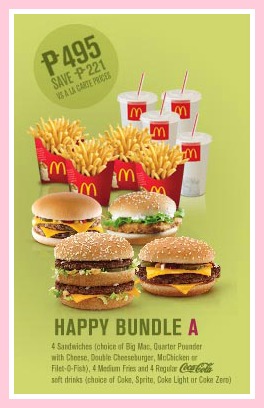

Winters bring with them, a lot more than chills – happiness, celebrations, festivities, families, gifts, love…..for everyone. And for businesses like yours and ours, a lot of warm sales.
We plan and strategies to make the holiday season work best to our benefits. That includes offering sales, promising discounts, running loyalty programs and taking customers by surprise with Christmas goodies. One thing, a lot of us miss, is bundling products up.
Creating product bundles that sell like hot cakes, is a science and an art. There is a lot of analysis that goes into it and only after a thorough study of your customers’ behaviour, their buying pattern and their shortlisting tendencies, can you create bundles that would actually boost your sales.
Ecommerce Product Bundles is a part of up-selling and cross-selling strategies. However, it’s important to know that there’s a difference between these. Refer the Amazon Example below.

Source: WooBeginner

Source: SellwithWP
Here is a complete set of answers to every possible why and how that you might be having, in relation with product bundles.
Why are product bundles so obviously enticing?
Here’s a scenario –
A pack of rainbow candies: 25$
A box of chocolate muffins : $40
A box of cookies : $38
Total cost to the buyer on buying each product individually would be $103
Bundle price: $95
Which one would you go for?
Ask me, I would choose the bundle’s price.
Benefit to me – I get all the products together at a few bucks less than the total cost if I bought all the products individually. Most probably, with Santa visiting my kid’s dreams every night, I would go for all the products, anyways. A bundle is giving me the convenience of finding everything related at one place, and at a lower price.
Benefit to the one I am buying from – He gets to see 3 different things, together, which I might otherwise have bought from someone else. I remember him because I remember the awesome ‘DEAL’ he gave me. I don’t view it as a discount. He gets my loyalty.
Your AOV (Average Order Value)
AOV can be described in layman terms, as revenue generated per conversion. Look more carefully at the definition, and you will find out, bundling increases your AOV. While offering discounts and offers on individual products gives people the choice of putting a lot of great deals into their shopping carts, it also gives them the liberty to go elsewhere in search of a yet better deal.
Bundled products gives them a reason to buy stuff, other than just being low priced. If you bundle up products wisely enough to make sure it offers value as a whole package, chances are, your visitors will drop the idea of comparing prices with your competitors’ offerings.
A bundle boosts up your buyers’ experience on your store.
Experience is a better motivator than low price frames.
Why is it all the more important during holiday seasons?
Because that is when people are on a buying frenzy. Because that is when gifting is at its peak. And because that is the time, when you can display your best offerings in full flair.
More importantly, because people are in a hurry and the least that they want to do is run through an endless range of categories and products, before they stumble upon something that they really need or actually like.
Offering them useful category bundles with different product sets to choose from, spares them the haggering agony of navigating through the entire store.
What are the different bundling strategies?
Yes, you heard it right. You can’t just go on and create a bundle according to your own fancies.
There are 3 basic rules of bundling up product:
- Bundle up the main product with accessories
- Bundle up the main product with related products
- Bundle up the main product with unrelated products, within the same category.
1. Mixed Bundling v/s Pure Bundling
Nintendo’s sales fell by 20% when it shifted from the Mixed Bundling strategy to Pure Bundling. So, what’s it all about.
Pure Bundling means you sell products only in bundles and not as individual products. Whereas, Mixed Bundling allows customers to purchase individual products as individual items or even as a part of an entire bundle.
As a WooCommerce Store Owner, you must always go for the Mixed Bundling Strategy and offer options to your customers otherwise they can postpone their purchases. Don’t force your options on them, let them decide.
If your WooCommerce Store sells products from different industries, you could also resort to cross industry bundling depending on your customers’ behavior, interests and shopping history.
Another way is to bundle a popular product with a less popular one to improve the latter’s awareness. It is important to note that if you are selling a variation of a parent product, you should never bundle it with the parent product. These products are just variations and do not complement each other.
For instance, you could list a red color ball as an individual product and even a pack of such balls with different colors. In such a scenario, you must not use product bundles. You must list it as a multi-pack.
2. Main Product with accessories

Source: Pages Flipper
A common example of this one would be how food chains like Mc Donald’s and Subway bundle up their main offerings with frill stuff. Subway, for example, bundles up sub sandwiches with a Coke and a cookie. The highest value offering here is the sandwich. Offered singularly, even for a takeaway, people might want to buy a Coke from elsewhere or might just not choose the cookie, because it is an extra. Under a bundle, the final offer price scales below the original price, which pulls strings here and there. After a sale of such a bundle happens, the vendor makes the profit without compromising on individual margins.
3. Main product with related products
Fashion apparel dealers use a lot of this. Offer a chic high heel boot with a sweet polka frock and dash it up with a sweet Hanukah perfume. Here, all the offerings scale an equal value, hence none of them serves an accessory. They are related to each other, however, considering the occasion whence all of them will be used together.

Source: Shopify
Main product with unrelated products, but of the same category
Kitchen electronics serves a good example here. Bundle up a refrigerator, a microwave, a coffee maker and an induction stove. Anybody moving into a new house for a solo stay would be an appropriate buyer for such a bundle. All of them fall under the common category of electronics, all of them are high value, hence not an accessory….and all of them are unrelated to each other.
How do you bundle them up in your WooCommerce Store?
There are plugins available for WordPress/WooCommerce, which help you create bundles. These plugins are designed to study your users’ navigation habit and suggest bundles accordingly. They are also tuned to analyze stuff from tools like Google Analytics. WC Product Bundles is one such plugin.
Apart from suggesting bundles, these plugins also keep a track of your products’ availability in stock, so that bundles can be tweaked in time to prevent the faulty display of data.
What if you earn through affiliate programs?
Let’s assume you are an Amazon affiliate and sell products that are listed on Amazon, through promotional activities on your website. In that case, too, you can create meaningful product bundles. That is possible with plugins like Fresh Bundle Master. Such tools allow you to create bundles right there on platforms like Amazon and embed that link onto your own website. Visitors coming in will know that there is such a product bundle, will be led to the bundle description on Amazon and will make their purchase using Amazon’s check out the system.
How can bundles be converted into interesting offers during the holiday season?
Bundle up your best selling items wisely and declare a ‘limited offer’ scheme. Or introduce a bottom strap of similar bundles. Better yet, introduce a free product on the purchase of a bundle. Playing with buyers’ psyche in such manners helps you boost your sales and increases your brand value in your visitor’s mind.
Pro Tips to ensure successful implementation of WooCommerce Product Bundles
- Learn how your visitors are behaving on the store and what kinds of products interest them the most. Accordingly, bundle the products to meet their holiday needs.
- Never force them to buy products in bundles. Always give them the option to purchase an individual item.
- WooCommerce Product Bundles are a great way to clear dead stock and increase the sale of items which are lagging behind. Promote such products in bundles.
- Always take a proper decision when pricing your bundled products. Some experts suggest premium bundling wherein the price of the entire bundle is more than the individual items. Carefully adopt such strategies considering what how your visitors are behaving. Keep checking your Google Analytics Reports for product bundles.
- Always run A/B Tests to see which types of product bundles are working more for your online store.
- Improve the exposure of specific products using E-commerce Product Bundle strategy which are new and haven’t seen much sales.
- Don’t be afraid to brand your bundles. Use compelling copy to persuade customers to go for bundled products instead of individual items. During the holiday season, people are looking to quickly buy stuff because they might not have much time. A cleverly executed product bundle strategy can skyrocket your sales.
E-commerce Product Bundle strategy can work wonders for your WooCommerce Store this holiday season when you carefully read and understand your customers’ mind. Focus on providing the best experience and give convenience to your visitors. You will be rewarded with revenues and sales you might have never imagined.
Happy holidays!
Learn More:


